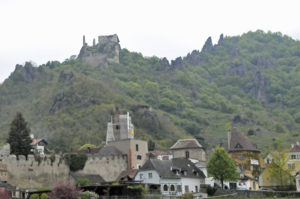
Ruins of Castle of Dürnstein, Austria (Photo by Don Knebel)
In 1188 A.D., King Richard joined Philip II, the King of France; Leopold V, the Duke of Austria; and other Christian rulers in the Third Crusade, seeking to take back the Holy Land from the Muslims. The Crusaders were successful in capturing significant territory, but were unable to retake Jerusalem, their primary objective. On his way back to England in 1192, Richard was captured by representatives of Leopold, who had been offended when Richard tore down the Austrian flag after a successful battle. Leopold held King Richard captive in a castle on the hill overlooking Dürnstein. He was eventually freed when England paid Leopold a ransom of about 100,000 pounds of silver, twice England’s annual income at the time. The money helped finance the construction of Wiener Neustadt (“New Vienna”)
Today, Dürnstein, with fewer than 1,000 residents, is one of the most popular tourist destinations in Austria’s picturesque Wachau Valley, famous for the quality of its wines and apricots. A sign on a street leading into town encourages people to climb the hill to the ruins of Dürnstein’s castle, where they can get a great view of the valley and learn the story behind the imprisonment of Richard the Lionheart. The sign notes that Leopold, called “the Virtuous,” was not able to spend the ransom money very long because, soon after being excommunicated by the Pope for kidnapping a fellow Crusader, he “fell from a horse and died unexpectedly.” In fact, Leopold died from gangrene after ordering one of his servants to hack off his broken foot with an axe.
Comments are closed.